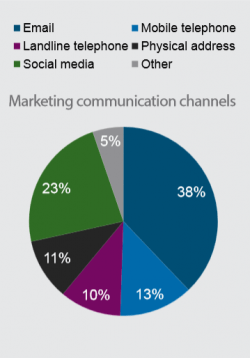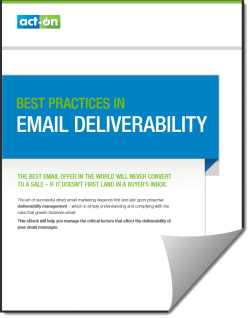 Have you ever been to a speed-dating event? You know, one of those things where bunches of people gather to try to find a prospective match? Time is limited, so the questions asked must cover the big picture: “What do you do for a living?” “Are you a cat or dog person?” or even “What’s your sign?” The point is that love-seekers want to find out as quickly as possible whether the person across the table will make a successful partner.
Have you ever been to a speed-dating event? You know, one of those things where bunches of people gather to try to find a prospective match? Time is limited, so the questions asked must cover the big picture: “What do you do for a living?” “Are you a cat or dog person?” or even “What’s your sign?” The point is that love-seekers want to find out as quickly as possible whether the person across the table will make a successful partner.
So what does this have to do with a blog post on marketing data? Well, if there was a speed-dating event where deliverability professionals met with email marketers, there is no doubt that one of the top questions asked by the deliverability crowd would be: “How clean are your lists?” This simple phrase is the deliverability pro’s version of “What’s your sign?” But why?
According to a new report published by Experian, “The Dark side of Email Deliverability,” over 60% of organizations have experienced email deliverability issues due to poor sender reputation. Sixty percent! In the report, Experian detailed the top four factors that negatively affect deliverability, which are:
- Spam trap hits
- High bounce rates
- Email complaints
- Blacklisting
If you are experiencing any of these issues, it is important to know that all four are directly tied to data maintenance.
Addressing Email List Deliverability Issues
So how can you combat these issues, and jump from the 60% of marketers experiencing deliverability issues – to the squeaky-clean 40% super-senders that deliverability pros like me geek out about? Let me tell you.
Email list cleaning
List cleaning is the practice of removing “dirty” email addresses from your marketing lists. Such cleaning can (among other things) identify known spam traps, Removing these will help you stay off blacklists.
Spam traps
If you’re not familiar with spam traps, they’re email addresses that have been set up by blacklist organizations and ISPs to measure data hygiene. (Blacklist organizations build lists of spammers and sell them to ISPs and global receivers, who then use them to guard the email gate from those identified spammers.) Spam traps look like active, valid email addresses: they don’t hard bounce and at times they may even engage with your mailings. However, if you mail to one, whoever set up the trap will see that you sent an email to a known bad address – and can blacklist you, thus harm your sending reputation.
Rented email lists
If you purchase or rent data, you are at a higher risk of sending to spam traps than if you mail only to your own lists. Mailing to rented or purchased lists makes regular list cleaning an absolute, ongoing necessity.
Even if your lists are 100% organically grown, you can still wind up sending to traps. “Recycled” spam traps are email addresses that were once active but have been abandoned. Recycled traps are typically converted into spam traps one year after deactivation, which shows why removing unengaged recipients on a regular schedule is important.
Email list validation
List validation is a great measure to take if you are seeing high hard bounce rates (that is, bounces due to a bad mailbox or bad domain). Companies who purchase or rent data, or send to old mailing lists, are most likely to experience high hard bounce rates, but even those with active mailing lists can experience hard bounces. According to Return Path, 2% of all contact data goes bad each month.
If your hard bounce rates are consistently above 1%, it is possible that receiving servers will block you. The list validation process checks your data to see whether the email addresses on your lists are active and working. This helps rid your database of old, inactive email addresses. However, as noted above, spam traps are active email addresses. If it sounds like it’s time for you to perform list validation, then it’s also a good time to perform list cleaning as well.
Email List Segmentation
Beyond cleaning and validating your lists, there are strategic marketing actions you can take to enhance your deliverability.
Segmentation – using one or more fields to create categories that correspond to a prospect’s attributes or interests – lets you send relevant content to targeted lists. You can segment by one or a number of attributes: title, industry, company size, last purchase made, group membership, web pages visited, webinars attended, et cetera, including any factor that has meaning in your industry and to your customers. If you use a marketing automation platform, once you set up segmentation, new contacts can be automatically funneled into the proper categories, taking the “manual” out of this labor. Segmentation is the key to relevance and engagement, making it a most important factor in sustaining long-term list hygiene.
Email content relevance
The days of “batch and blast” email marketing are long gone. If you send the same email to everyone, at least some of those receivers will find that email irrelevant. A typical outcome: you will be hit with mass unsubscribes or experience high spam complaints, or both. Neither of these developments contributes to sustained deliverability, and high spam complaints can even lead to blacklisting. You need to find a way to target a relevant message to the receiver.
Email engagement
As you execute your email marketing program, keep track of who is opening and clicking messages. Engagement is the key metric used by ISPs to measure your sender reputation. If a receiving server sees there is little to no engagement with your emails historically, they will likely start to block you. To combat this, move any recipient who has not opened or clicked a message in the previous 12 months out of the active mailing list.
 Conclusion
Conclusion
So just how clean are your lists? Go ahead and think about it for a minute. Whether you’ve never considered the topic or you think your lists are as clean as a whistle, taking stock of your data is a good place to start in determining how clean your lists are.
Maintaining clean and accurate data may seem like a chore, but it is vital for achieving sustained deliverability.
In a world where email is the top marketing channel, keeping clean data is something that will not only curry favor at a deliverability speed-dating event, but also contribute to a positive sender reputation for long-term ROI success.
For more information about email deliverability,
download Act-On’s
“Best Practices in Email Deliverability” eBook.

